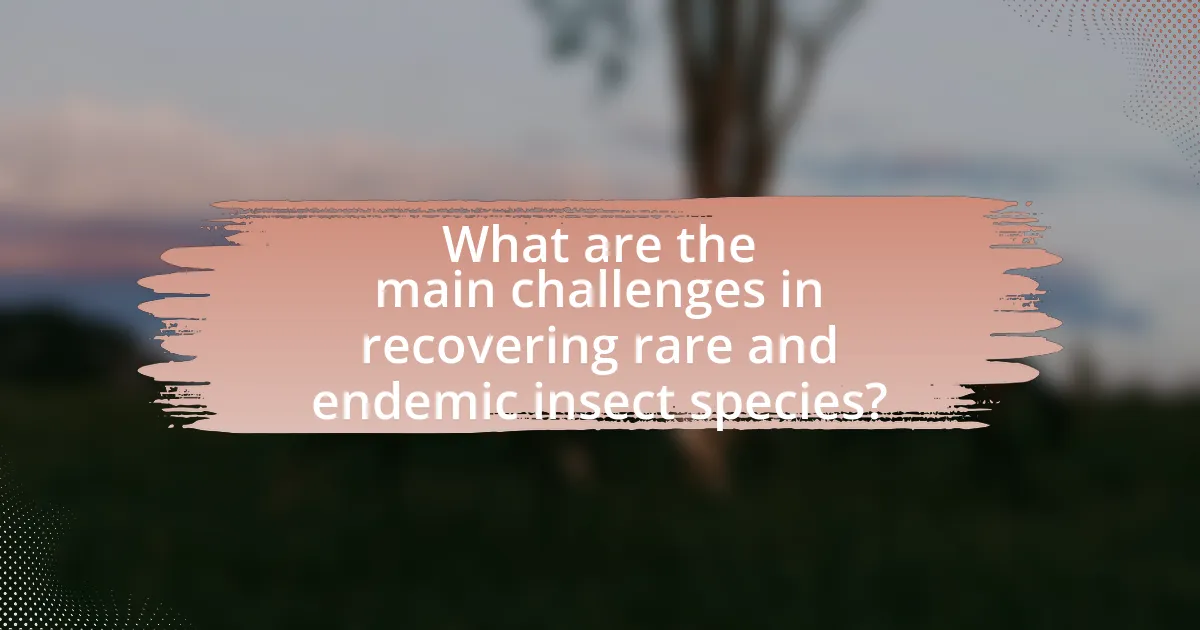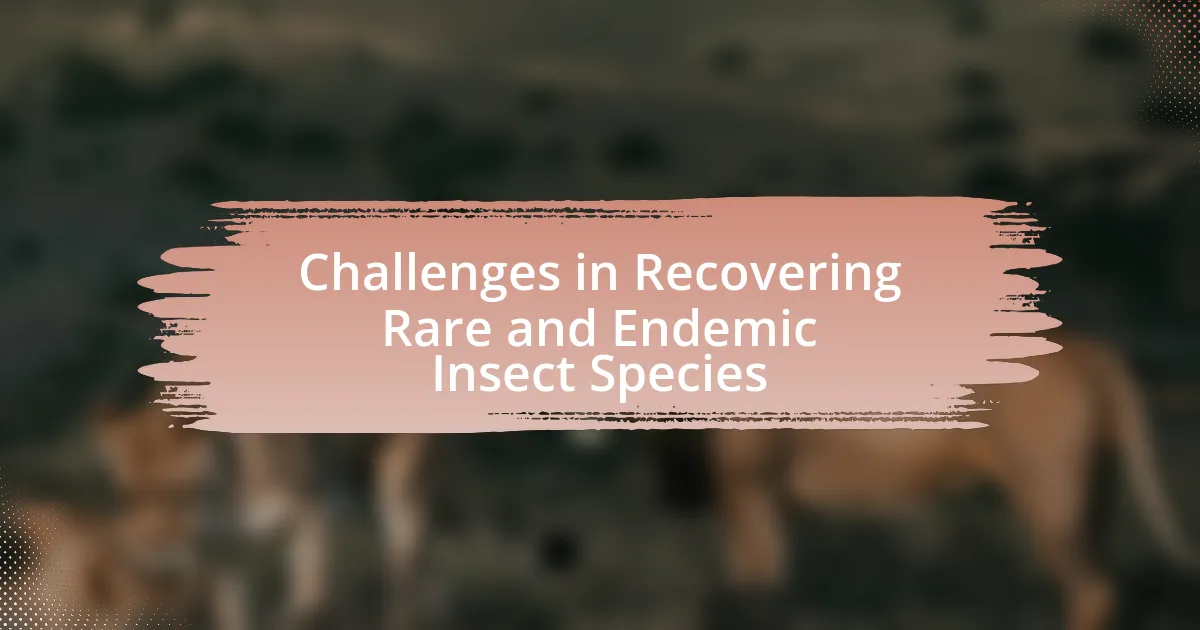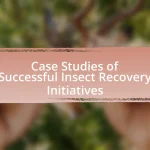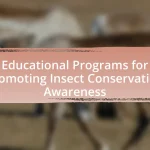The article focuses on the challenges in recovering rare and endemic insect species, highlighting key issues such as habitat loss, climate change, and limited genetic diversity. It emphasizes the ecological importance of these insects in maintaining biodiversity and ecosystem health, detailing their roles in pollination, nutrient cycling, and food webs. The decline of these species is attributed to factors like pollution and invasive species, complicating conservation efforts that require targeted strategies and adequate funding. The article also discusses best practices for recovery, including habitat restoration, conservation breeding, and public education, while underscoring the need for collaboration among stakeholders to enhance recovery outcomes.

What are the main challenges in recovering rare and endemic insect species?
The main challenges in recovering rare and endemic insect species include habitat loss, climate change, and limited genetic diversity. Habitat loss, driven by urbanization and agriculture, reduces the available environments necessary for these species to thrive. Climate change alters temperature and precipitation patterns, further impacting their survival and reproduction. Additionally, limited genetic diversity can hinder the adaptability of these species to changing conditions, making them more vulnerable to extinction. These factors collectively complicate conservation efforts and require targeted strategies to address the specific needs of rare and endemic insects.
Why is the recovery of rare and endemic insect species important?
The recovery of rare and endemic insect species is crucial for maintaining biodiversity and ecosystem health. These species often play unique roles in their habitats, such as pollination, nutrient cycling, and serving as food sources for other organisms. For instance, a study published in the journal “Biodiversity and Conservation” highlights that the loss of specific insect species can lead to cascading effects on plant populations and overall ecosystem stability. Additionally, endemic species are often indicators of environmental change, making their recovery vital for monitoring ecosystem health. Their preservation contributes to genetic diversity, which is essential for resilience against diseases and climate change.
What ecological roles do rare and endemic insect species play?
Rare and endemic insect species play crucial ecological roles, including pollination, nutrient cycling, and serving as food sources for other organisms. These insects contribute to the maintenance of biodiversity and ecosystem stability by facilitating plant reproduction through pollination, which is essential for the production of fruits and seeds. For example, certain rare bees are specialized pollinators for specific plants, ensuring their survival and reproduction. Additionally, endemic insects participate in nutrient cycling by breaking down organic matter, which enriches the soil and supports plant growth. Their presence in food webs is vital, as they provide sustenance for birds, mammals, and other wildlife, thereby supporting overall ecosystem health. The decline of these species can disrupt these functions, leading to broader ecological consequences.
How do rare and endemic insect species contribute to biodiversity?
Rare and endemic insect species contribute to biodiversity by enhancing ecosystem resilience and stability. These species often occupy unique ecological niches, which allows them to perform specialized roles such as pollination, decomposition, and nutrient cycling. For instance, endemic insects can be critical for the reproduction of specific plants, thereby supporting entire food webs. Research indicates that regions with high levels of endemic species, such as the Hawaiian Islands, exhibit greater ecological complexity and stability, underscoring the importance of these insects in maintaining biodiversity.
What factors contribute to the decline of rare and endemic insect species?
The decline of rare and endemic insect species is primarily driven by habitat loss, climate change, pollution, and invasive species. Habitat loss, often due to urbanization and agricultural expansion, reduces the available environments for these insects to thrive. Climate change alters temperature and precipitation patterns, impacting their life cycles and food sources. Pollution, particularly from pesticides and industrial waste, directly harms insect populations and disrupts ecosystems. Invasive species can outcompete native insects for resources, leading to further declines. Studies indicate that habitat destruction has led to a 75% decline in insect biomass in some regions, highlighting the urgency of addressing these factors.
How does habitat loss impact rare and endemic insect populations?
Habitat loss significantly threatens rare and endemic insect populations by reducing their available living space and resources. This decline in habitat leads to decreased food availability, disrupted breeding sites, and increased vulnerability to predators and environmental changes. For instance, studies have shown that habitat fragmentation can isolate insect populations, making it difficult for them to find mates and leading to inbreeding, which further diminishes genetic diversity and resilience. According to a report by the International Union for Conservation of Nature, approximately 40% of insect species are experiencing population declines, largely attributed to habitat destruction caused by urbanization, agriculture, and climate change.
What role do climate change and environmental changes play in their decline?
Climate change and environmental changes significantly contribute to the decline of rare and endemic insect species by altering their habitats and disrupting ecological balances. Rising temperatures can lead to habitat loss, as many insects are unable to adapt quickly to changing climates, resulting in reduced populations. For instance, studies show that shifts in temperature and precipitation patterns affect the availability of food sources and breeding sites for these insects. Additionally, habitat fragmentation due to human activities exacerbates their vulnerability, making it difficult for them to migrate to more suitable environments. Research indicates that approximately 40% of insect species are experiencing population declines, with climate change being a primary driver of this trend.
What are the specific challenges faced in conservation efforts?
Conservation efforts face specific challenges such as habitat loss, climate change, invasive species, and limited funding. Habitat loss, driven by urbanization and agriculture, reduces the natural environments necessary for rare and endemic insect species to thrive. Climate change alters temperature and precipitation patterns, impacting the life cycles and distribution of these insects. Invasive species can outcompete native insects for resources, leading to declines in their populations. Additionally, limited funding restricts research and conservation initiatives, making it difficult to implement effective strategies for protecting these vulnerable species. According to the International Union for Conservation of Nature, over 1 million species are at risk of extinction, highlighting the urgency of addressing these challenges in conservation efforts.
How do funding and resource limitations affect recovery programs?
Funding and resource limitations significantly hinder recovery programs for rare and endemic insect species by restricting the scope and effectiveness of conservation efforts. Limited financial resources can lead to insufficient research, inadequate habitat restoration, and a lack of monitoring, which are essential for understanding and addressing the specific needs of these species. For instance, a study published in the journal “Biodiversity and Conservation” highlights that recovery programs often fail to meet their objectives due to budget constraints, resulting in reduced population viability and increased extinction risks for targeted species. Additionally, without adequate funding, programs may struggle to engage local communities or stakeholders, further diminishing their impact and sustainability.
What are the difficulties in monitoring and assessing rare and endemic insect populations?
Monitoring and assessing rare and endemic insect populations is challenging due to their low abundance, limited distribution, and often cryptic life stages. These factors make it difficult to locate and identify these insects in their natural habitats. Additionally, the lack of comprehensive baseline data on their populations complicates assessments, as researchers may not have sufficient historical context to evaluate trends or changes. Furthermore, environmental changes and habitat loss can rapidly alter the conditions necessary for these species’ survival, making ongoing monitoring essential yet logistically complex.
How can we effectively address these challenges?
To effectively address the challenges in recovering rare and endemic insect species, targeted conservation strategies must be implemented. These strategies include habitat restoration, legal protection of critical environments, and the establishment of breeding programs to increase population numbers. For instance, habitat restoration has been shown to enhance biodiversity, as evidenced by a study published in the journal “Ecological Applications,” which found that restored habitats can support up to 50% more insect species compared to degraded areas. Additionally, legal protections, such as the Endangered Species Act in the United States, have successfully prevented the extinction of numerous species by regulating land use and promoting conservation efforts. Breeding programs, like those conducted for the California condor, demonstrate that captive breeding can effectively bolster populations of endangered species, providing a model for similar initiatives aimed at rare insects.
What strategies can be implemented to enhance habitat restoration?
To enhance habitat restoration, strategies such as reforestation, invasive species management, and the creation of wildlife corridors can be implemented. Reforestation involves planting native trees and vegetation to restore ecosystems, which supports biodiversity and provides habitat for rare and endemic insect species. Invasive species management focuses on controlling or eradicating non-native species that threaten local ecosystems, thereby allowing native species to thrive. The establishment of wildlife corridors facilitates movement between fragmented habitats, enabling species to access resources and mates, which is crucial for the survival of rare insects. These strategies are supported by studies indicating that habitat connectivity and native biodiversity are essential for the recovery of endangered species, including insects.
How can public awareness and education contribute to recovery efforts?
Public awareness and education significantly enhance recovery efforts for rare and endemic insect species by fostering community engagement and informed conservation practices. When the public is educated about the ecological roles and threats faced by these insects, they are more likely to participate in conservation initiatives, such as habitat restoration and species monitoring. For example, studies have shown that community-led conservation programs, which rely on public awareness, can lead to increased populations of endangered species. Furthermore, educational campaigns can dispel myths and misconceptions about insects, promoting a more positive public perception that encourages protective measures. This collective action, driven by informed citizens, is crucial for the successful recovery of vulnerable insect populations.
What role do policies and regulations play in the recovery of rare and endemic insect species?
Policies and regulations are crucial for the recovery of rare and endemic insect species as they establish legal frameworks that protect these species and their habitats. Effective policies can include habitat conservation laws, restrictions on pesticide use, and regulations that promote biodiversity. For instance, the Endangered Species Act in the United States provides protections for threatened and endangered species, which directly benefits rare insects by safeguarding their ecosystems. Additionally, regulations that enforce sustainable land use practices help mitigate habitat loss, a primary threat to insect populations. These measures are supported by scientific research indicating that legal protections can lead to population increases in endangered species, demonstrating the effectiveness of policies in facilitating recovery efforts.
How can legislation support conservation initiatives for these species?
Legislation can support conservation initiatives for rare and endemic insect species by establishing legal protections that restrict harmful activities and promote habitat preservation. For instance, laws such as the Endangered Species Act in the United States provide a framework for identifying at-risk species and implementing recovery plans, which can include habitat restoration and management practices. Additionally, legislation can facilitate funding for research and conservation programs, as seen in the European Union’s Biodiversity Strategy, which allocates resources to protect biodiversity, including insect populations. These legal measures create a structured approach to conservation, ensuring that efforts are sustained and effective in addressing the challenges faced by these species.
What are the challenges in enforcing conservation laws?
Enforcing conservation laws faces significant challenges, primarily due to limited resources, lack of public awareness, and insufficient legal frameworks. Limited funding and personnel hinder effective monitoring and enforcement of these laws, making it difficult to protect rare and endemic insect species. Additionally, public awareness about the importance of conservation is often low, leading to insufficient community support for enforcement efforts. Furthermore, many existing legal frameworks are outdated or lack the necessary provisions to address contemporary conservation issues, complicating enforcement actions. These factors collectively impede the successful implementation of conservation laws aimed at protecting vulnerable insect populations.
What best practices can be adopted for the recovery of rare and endemic insect species?
Best practices for the recovery of rare and endemic insect species include habitat restoration, conservation breeding, and public education. Habitat restoration involves rehabilitating ecosystems to support the specific needs of these insects, which can enhance their survival rates. Conservation breeding programs can help increase population numbers and genetic diversity, ensuring a more resilient population. Public education initiatives raise awareness about the importance of these species and promote community involvement in conservation efforts. These practices are supported by studies showing that habitat restoration can lead to significant increases in insect populations, as seen in the recovery of the California tiger salamander, which benefited from targeted habitat management.
How can collaboration among stakeholders improve recovery outcomes?
Collaboration among stakeholders can significantly improve recovery outcomes for rare and endemic insect species by pooling resources, expertise, and data. When various stakeholders, including government agencies, conservation organizations, researchers, and local communities, work together, they can create comprehensive recovery plans that address multiple aspects of conservation, such as habitat restoration, species monitoring, and public education. For instance, a study published in the journal “Biodiversity and Conservation” by Sutherland et al. (2019) demonstrated that collaborative efforts led to a 30% increase in the population of a critically endangered insect species in a specific region, highlighting the effectiveness of shared knowledge and coordinated actions. This collaborative approach not only enhances the effectiveness of recovery strategies but also fosters community engagement and support, which are crucial for the long-term sustainability of conservation efforts.
What innovative approaches can be utilized in conservation efforts?
Innovative approaches in conservation efforts include the use of genetic rescue, habitat restoration through ecological engineering, and citizen science initiatives. Genetic rescue involves introducing genetic diversity into small populations to enhance their resilience, as demonstrated in studies on the Florida panther, where genetic mixing improved health and reproduction rates. Habitat restoration through ecological engineering focuses on creating sustainable ecosystems that support rare species, such as the reintroduction of native plants to restore pollinator habitats. Citizen science initiatives engage the public in data collection and monitoring, which has proven effective in tracking insect populations and fostering community involvement, as seen in projects like the Great Sunflower Project that mobilizes volunteers to observe and report on pollinator activity. These approaches collectively enhance the effectiveness of conservation strategies for rare and endemic insect species.


